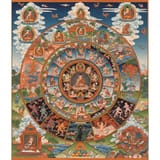Search Results
!/T2Ij.GdEA/x/40762169#40766771
7/21/2025, 6:01:11 AM
>>40762169
Hi I'm supposed to be banned right now.
Hi I'm supposed to be banned right now.
!IY3lmS5eXQ/x/40753116#40753119
7/19/2025, 4:01:55 AM
The Bhavachakra, often called the "Wheel of Life" or "Wheel of Becoming," is a powerful and intricate symbolic representation of Buddhist teachings, especially about samsara (cyclic existence), karma (cause and effect), and the path to liberation from suffering. It's commonly found as a mural outside Tibetan Buddhist temples, acting as a visual guide for practitioners and laypeople.
Here's a breakdown of the story and symbolism within the Bhavachakra:
1. The Figure Holding the Wheel: Impermanence (Yama)
The entire wheel is held by a fierce, wrathful figure, often identified as Yama, the Lord of Death, or a demon representing impermanence. This signifies that all beings within samsara, regardless of their realm, are subject to death and the constant cycle of change. Yama's attributes (like a crown of skulls or a third eye) symbolize the impermanence of all things and the wisdom to understand it.
2. The Hub: The Three Poisons
At the very center of the wheel are three animals, chasing each other in a circle, symbolizing the Three Poisons (or Three Root Kleshas) that drive the entire cycle of suffering:
Pig: Represents ignorance (or delusion). The pig is often depicted as the root, as ignorance is seen as the fundamental cause from which other defilements arise.
Snake: Represents aversion (or hatred/anger).
Rooster/Bird: Represents attachment (or greed/desire/clinging).
These animals bite each other's tails, showing how these poisons feed into and perpetuate one another.
Here's a breakdown of the story and symbolism within the Bhavachakra:
1. The Figure Holding the Wheel: Impermanence (Yama)
The entire wheel is held by a fierce, wrathful figure, often identified as Yama, the Lord of Death, or a demon representing impermanence. This signifies that all beings within samsara, regardless of their realm, are subject to death and the constant cycle of change. Yama's attributes (like a crown of skulls or a third eye) symbolize the impermanence of all things and the wisdom to understand it.
2. The Hub: The Three Poisons
At the very center of the wheel are three animals, chasing each other in a circle, symbolizing the Three Poisons (or Three Root Kleshas) that drive the entire cycle of suffering:
Pig: Represents ignorance (or delusion). The pig is often depicted as the root, as ignorance is seen as the fundamental cause from which other defilements arise.
Snake: Represents aversion (or hatred/anger).
Rooster/Bird: Represents attachment (or greed/desire/clinging).
These animals bite each other's tails, showing how these poisons feed into and perpetuate one another.
Page 1
